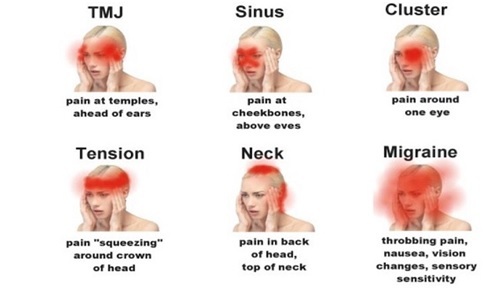Classification

MIGRAINE CLASSIFICATION AND DIAGNOSIS CRITERIA
3.1) International Headache Society Classification of Migraine
3.1.1 Migraine without aura
3.1.2 Migraine with aura
- Migraine with typical aura
- Migraine with prolonged aura
- Familial hemiplegic migraine
- Basilar migraine
- Migraine aura without headache
- Migraine with acute onset aura
3.1.3 Opthalmoplegic migraine
3.1.4 Retinal migraine
3.1.5 Childhood periodic syndromes that may be precursors to or associated with migraine
- Benign paroxysmal vertigo of childhood
- Alternating hemiplegia of childhood
3.1.6 Complications of migraine
- Status migrainous
- Migrainous infarction
3.1.7 Migrainous disorder not fulfilling above criteria
3.2) Other Classification of Migraine
3.2.1 Migraine without Aura (formerly called Common Migraine). This is the most frequent type of Migraine. Symptoms include moderate to severe pulsating headache pain that occurs without warning and is usually felt on one side of the head It comes along with nausea, confusion, blurred vision, mood changes,fatigue, and increased sensitivity to light, sound, or smells. Attacks typically last 4-72 hours, and they repeat a few times a year to a few times a week. Movement generally makes the attack worse. Importantly, this Migraine without Aura is the type more prone to worsen with frequent use of symptomatic medication.
3.2.2 Migraine with Aura (formerly called Classic or Complicated Migraine). This type of Migraine includes visual disturbances and other neurological symptoms that appear about 10 to 60 minutes before the actual headache and usually last no more than an hour. You may temporarily lose part or all of your vision. The aura may occur without headache pain, which can strike at any time. Less frequent aura symptoms include an abnormal sensation, numbness, or muscle weakness on one side of the body; a tingling sensation in the hands or face; trouble speaking; and confusion. Nausea, loss of appetite, and increased sensitivity to light, sound, or noise may precede the headache.
3.2.3 Migraine without Headache is characterized by visual problems or other aura symptoms, nausea, vomiting, and constipation, but without head pain.Technically, this is known as Typical Aura without Headache. Headache specialists have suggested that fever, dizziness, and or unexplained pain in a particular part of the body could also be possible types of headache-free Migraine. It’s different from the complications known as Abdominal Migraine and Cyclical Vomiting Syndrome, which often occur in children.
3.2.4 Migraine with Brain stem Aura (formerly called Basilar-Type Migraine) mainly affects children and adolescents; this includes Migraine with Aura symptoms that originate from the brain stem, but without motor weakness. It occurs most often in teenage girls and may be associated with their menstrual cycles. Symptoms include partial or total loss of vision or double vision, dizziness and loss of balance (vertigo), poor muscle coordination, slurred speech, a ringing in the ears (tinnitus), and fainting. The throbbing pain may come on suddenly and is felt on both sides at the back of the head.
3.2.5 Hemiplegic Migraine (a sub-type of Migraine with Aura) is a rare but severe form of Migraine that causes temporary paralysis – sometimes lasting several days – on one side of the body prior to or during a headache. Symptoms such as vertigo, a pricking or stabbing sensation, and problems seeing, speaking, or swallowing may begin prior to the headache pain and usually stop shortly thereafter. When it runs in families, the disorder is called Familial Hemiplegic Migraine (FHM). Though rare, at least three distinct genetic forms of FHM have been identified. These genetic mutations make the brain more sensitive or excitable, most likely by increasing brain levels of a chemical called glutamate. Read a Migraine Journey about a Hemiplegic Migraine patient.
3.2.6 Retinal Migraine is a very rare type of Migraine characterized by attacks of visual loss or disturbances in one eye. These attacks, like the more common visual auras, are usually associated with Migraine headaches.
3.2.7 Chronic Migraine is
characterized by headaches occurring on 15 or more days per month for more than
3 months, which have the features of Migraine headache on at least 8 days per
month. They can be with or without aura, they usually require preventative
medications and behaviors to control, and they are often disabling. After drug
withdrawal, about half of Chronic Migraine patients revert to Episodic Migraine
and half do not.
